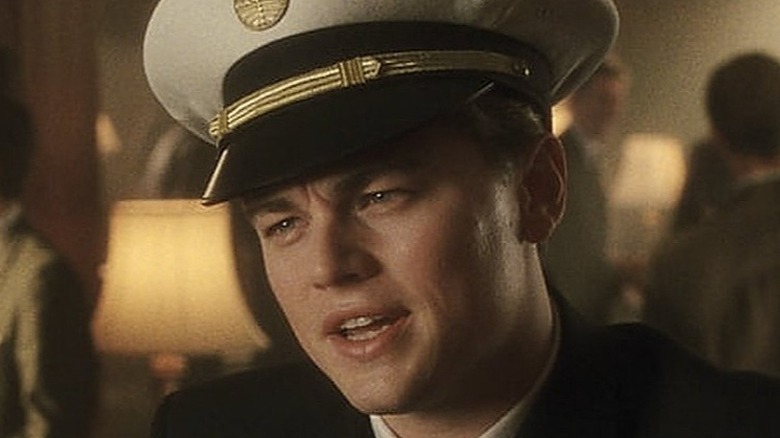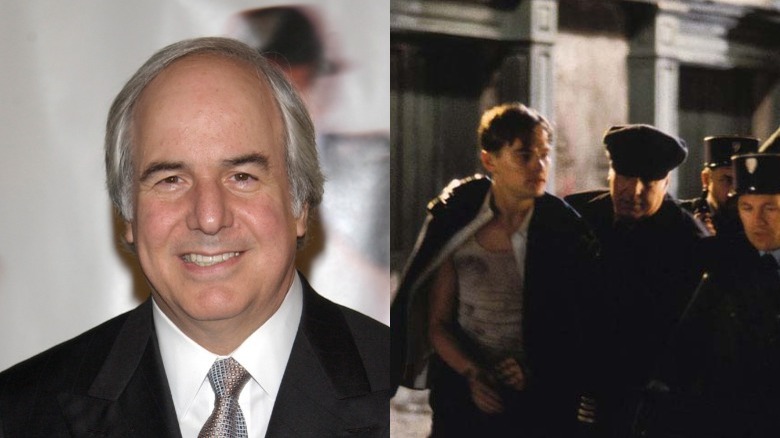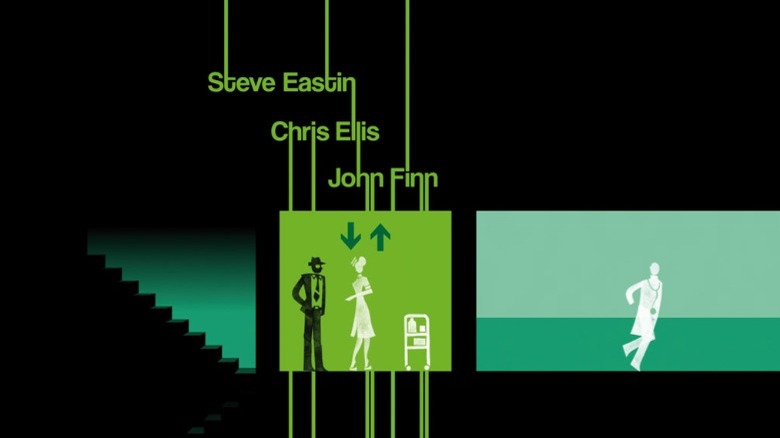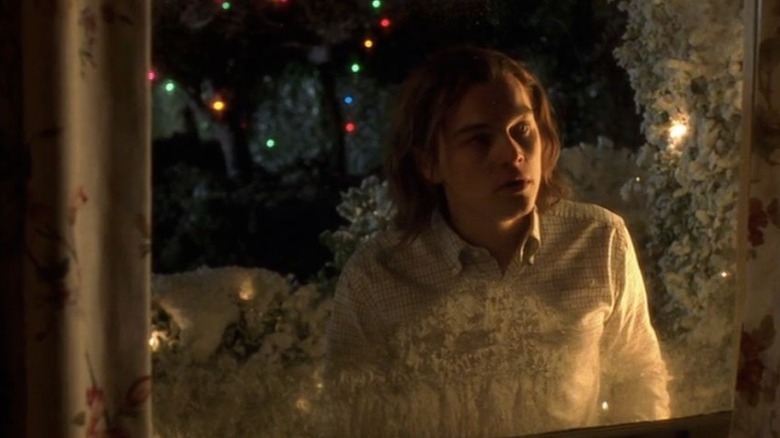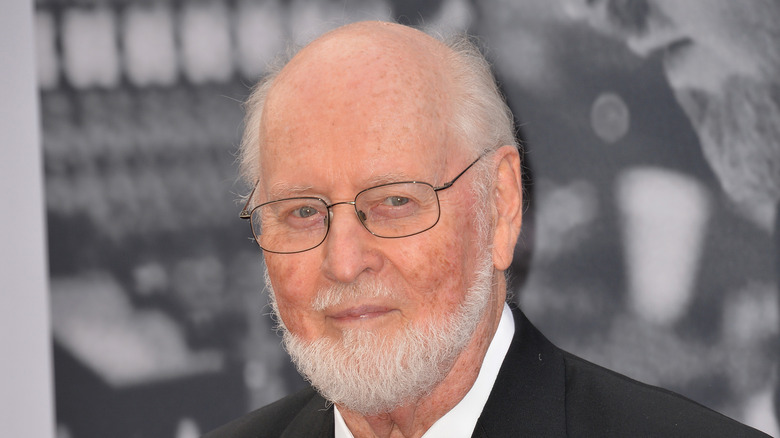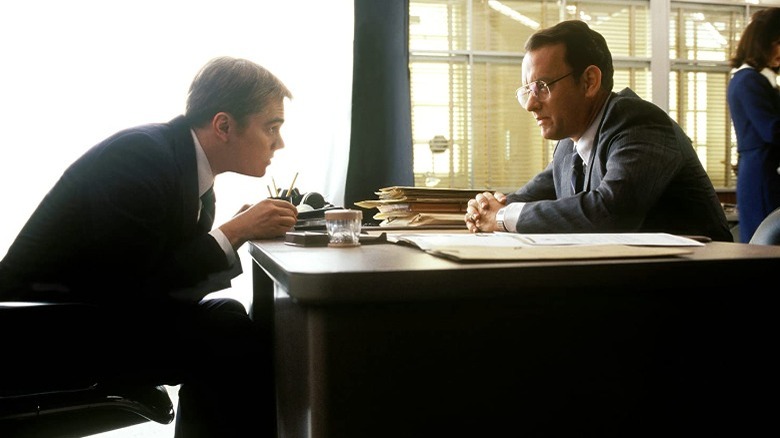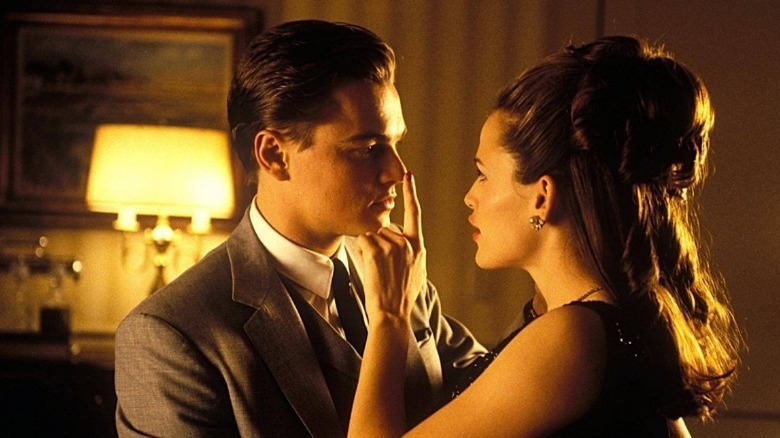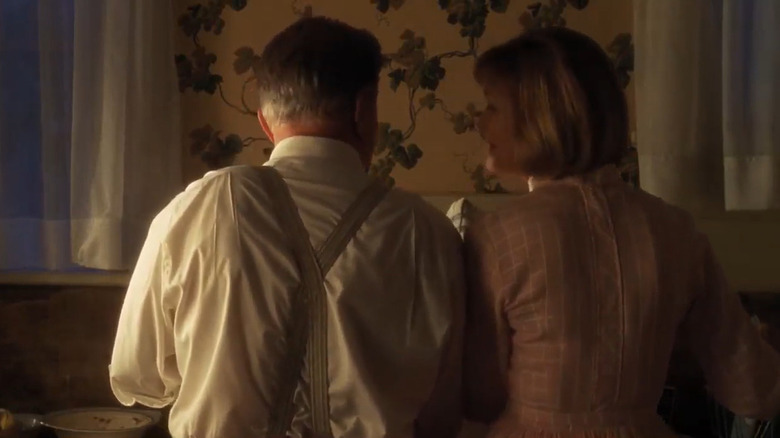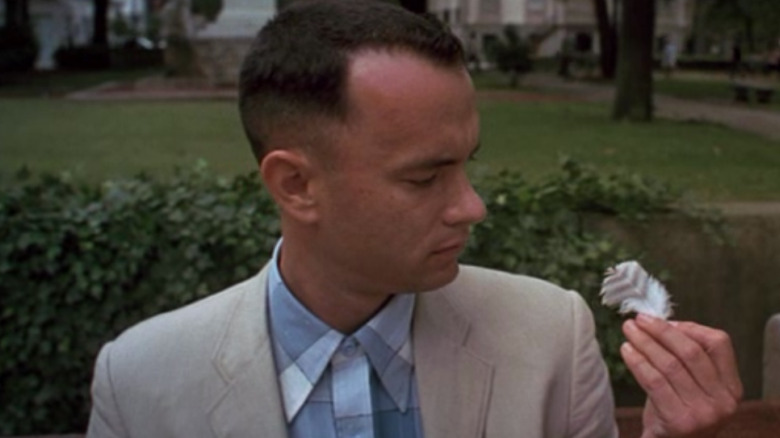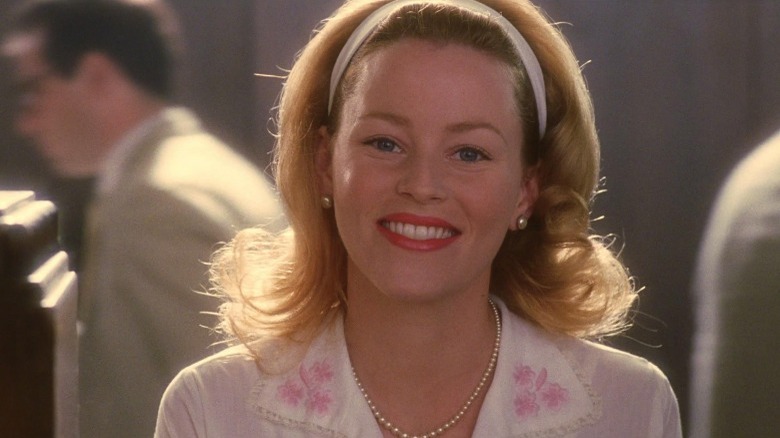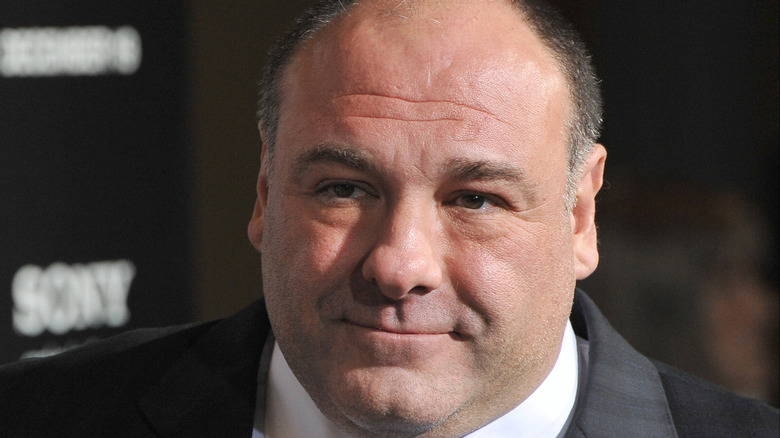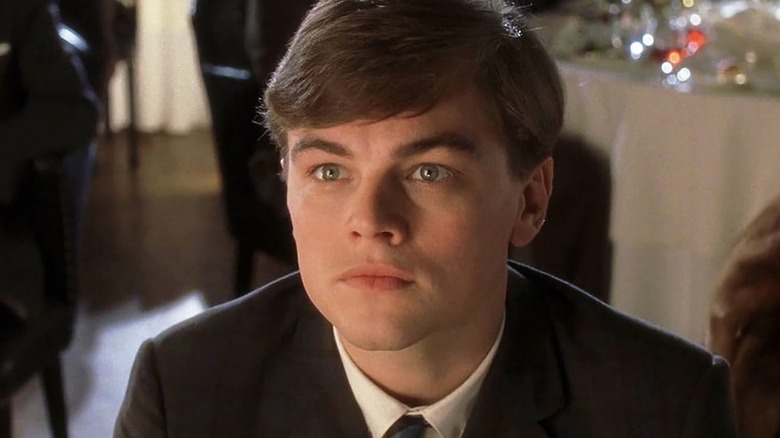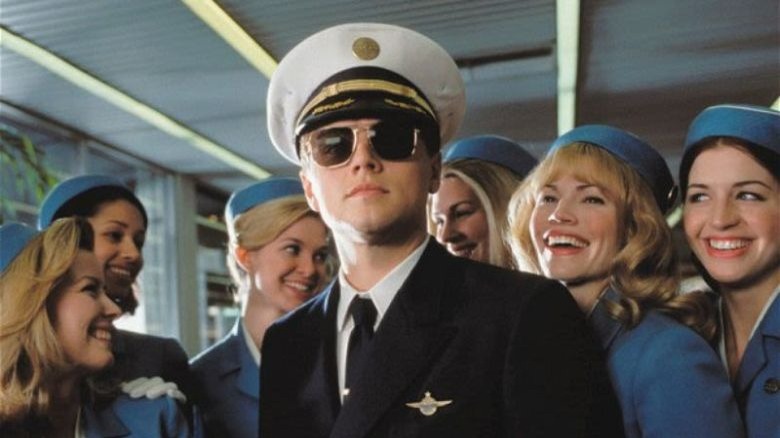Things In Catch Me If You Can You Only Notice After A Rewatch
The 2002 crime film "Catch Me If You Can" is one of those movies you watch every time you flip by it on cable (or you would, if anyone had cable anymore). It's a timeless coming-of-age story and the ultimate con man flick. Based on the real-life exploits of a teenager who allegedly posed as a pilot, doctor, and lawyer while passing millions of dollars in fraudulent checks and running from the law, it's one of the rare cases of the truth being stranger than fiction.
But chances are, without cable or even many DVDs in the world these days, you haven't seen this film in a while. You probably remember it as equal parts far-fetched and entertaining, but it's possible you missed some of this wickedly smart film's less-apparent details. Many of them, like visual callbacks to cast members' other films and hidden clues in the opening titles, require multiple viewings to uncover. These are the things in "Catch Me If You Can" you only notice after a re-watch.
The real Frank Abagnale Jr. makes a cameo
"Catch Me If You Can" is based on a memoir of the same name by the real Frank Abagnale Jr. While he sold the movie rights to his memoir the year it was published, all the way back in 1980, the movie wouldn't be made for another 22 years after going through a series of production companies and directors. Finally, Steven Spielberg's studio, DreamWorks, bought the rights to the film, and Spielberg ultimately decided to direct the movie himself.
Abagnale was invited to the set of the film, and even though his con artist days were long behind him, he still had all of the natural, instinctive charm that made his schemes possible. Leonardo DiCaprio told IGN that everyone stopped what they were doing to listen to Abagnale: "All of the sudden [sic], the entire cast and crew had taken an impromptu lunch break. You know, right after coming out of lunch. And they're just listening to him retell these stories of the past." Apparently, Abagnale was so charming that he ended up in the film in a blink-and-you'll-miss-it cameo as one of the French policemen who finally catch up with Frank near the end of the film. It must be surreal to put yourself in the back of a police car.
The opening titles spoil the entire film
The vibrant, colorful opening titles for "Catch Me If You Can" were designed to harken back to the legendary title sequences of Saul Bass in the '60s and '70s. Most famous for his work on Alfred Hitchcock films like "North By Northwest," "Vertigo," and "Psycho," Bass livened things up with kinetic typography and moods specific to each film. "Catch Me If You Can" designers Florence Deygas and Olivier Kuntzel used Bass as a jumping-off point, and also drew inspiration from the document-forging methods of the film's subject. Deygas explained to Art of the Title, "We used the same techniques as the film's protagonist, by imagining the characters in stamp form, made from the same cutters as those used in the film by Frank Abagnale Jr. We wanted to preserve that crudeness."
Re-watching the movie, you can't help but wonder if a "spoiler alert" would have been useful, as the cut-out characters in the sequence actually act out the entire plot of the film: A paper FBI agent chases a paper con man from frame to frame as he becomes a pilot, a doctor, and a lawyer to stay one step ahead.
Catch Me If You Can is a Christmas movie
Tired of the seemingly endless "'Die Hard' is a Christmas movie!" discussions and fresh out of other stealth Christmas movies to watch during the holidays? Don't sleep on "Catch Me If You Can," which upon revisiting contains not just one, nor two or three, but four Christmases.
The film opens on Christmas Eve in 1969, as FBI agent Carl Hanratty arrives at a French prison to attempt to extradite a captive Frank, whom he's been hunting for years. The film then flashes back to Christmas six years earlier, beginning the story with Frank's happy family at the holidays in 1963. After his parents split up, Frank runs away to begin his life of crime — but calls Carl on Christmas Eve in 1965 and 1966, mostly because he has no one else to talk to.
When Carl finally catches up with Frank, it just so happens to be on Christmas Eve in 1967! Frank even wonders aloud, "How is it we're always talking on Christmas, Carl?", which is probably a better question for the screenwriter. After Frank presumably spends Christmas 1968 languishing in horrible French prison conditions, we return to Christmas 1969 as he makes a brief escape to try and see his mother one last time.
To top everything off, "Catch Me If You Can" was released on Christmas Day in 2002.
It has the least John Williams-y John Williams score
When you think of a John Williams score, you might hear the booming horns of the "Star Wars" fanfare, or perhaps the majestic, swooning strings from "Jurassic Park," or the Halloween-ified full orchestra performing Williams' main theme for the "Harry Potter" films. He's one of the most prolific and accomplished composers in any era of film, and was one of only two Oscar nominees for his work on "Catch Me If You Can," along with Christopher Walken in the Best Supporting Actor category.
While it's certainly not a surprise for him to score a film for longtime collaborator Steven Spielberg, it can be easy to forget that he worked on this film until you see his name in the credits. From the opening theme onward, the music is ... downright jazzy. There's a proliferation of xylophones, acoustic bass being plucked, and deep-throated alto saxophones. There are no booming horns or lush string arrangements whatsoever. To channel the 1960s, Williams drew on the earliest days of his musical career (he started out as a jazz pianist) and created by far the lightest, bubbliest score for a Steven Spielberg film.
Frank Abagnale Jr. becomes a narc
The appeal of the con artist story is one of escapism. If we were just a more brazen and at-ease-in-the-world version of ourselves, we could do that! "Catch Me If You Can," in both book and movie form, is an irresistible tale of what's possible with a smile and a little confidence — and the much less secure checking account procedures of the 1960s. The exploits of Frank Abagnale Jr. are all the more involving because they were accomplished by a teenage kid with nothing more than a big smile and hardly any fear. Riches, love, world travel — they're all just a bit of confidence away.
But having seen the ending, it's not as much fun to follow Frank's exploits: He totally becomes a narc at the end. Granted, it's his only option to get out of a much longer prison sentence, but after cashing millions of dollars in fraudulent checks, he immediately and without hesitation starts helping the FBI catch other check forgers, spilling the dirt on the current tricks of the trade. You'd think the least he could do is serve his time and not ruin things for everybody else, but there's truly no honor among thieves.
It has a strange attitude toward sex
In the decades since "Catch Me If You Can" hit theaters, attitudes have changed significantly about the role of sex and love scenes in film. With its lighthearted tone and young protagonist, this breezy adventure movie with just a PG-13 rating can't be too problematic, can it?
After a second viewing, it's sort of uncomfortable to think about. As Frank starts to pass bad checks and save up cash, we see him use his false identities as a pilot and then a doctor to romance multiple women into bed. The film treats this with a very "all in good fun!" attitude, without ever stopping to address that not only does he spend years lying to women to sleep with them, he's underage for the majority of that time, making it even more morally queasy.
The scene that's aged the worst is one in which Jennifer Garner, fresh off the success of "Alias," plays a model who moonlights as a sex worker. She agrees to sleep with Frank for 1,000 dollars — and not only does he pay her with a phony check, it's actually one for $1400, so she gives him $400 back. A scene presented as the height of hilarity is one in which our hero doesn't pay a sex worker and cons her out of 400 bucks? One doubts that would survive to the final cut in modern times.
All parents dance to the same song, apparently
A small detail you may catch upon re-watching is a striking similarity between two scenes about family. Early in the film, Frank watches his parents dance to a version of the song "Embraceable You" by Judy Garland and Victor Young. He smiles, unaware that soon his father's IRS problems will lead to his parents' divorce. Much later, while attempting to settle down despite posing as a phony doctor named "Frank Connors," he watches his fiancée Brenda's parents dance as well, in a quiet moment while they're doing the dishes together. And you'll never believe what song they're listening to.
Steven Spielberg is many things, but subtle is not one of them. We probably could have connected these two moments on our own, since Frank is pretty obviously attempting to rebuild the happy family life that was taken from him by trying to hide in Brenda's life. But just in case we needed a hint, the selfsame version of "Embraceable You" from earlier in the film is piped in to drive the connection home.
The Forrest Gump reference
When Tom Hanks' Agent Carl Hanratty once again nearly catches Frank in New Orleans, there's a small nod to one of Hanks' most famous roles. Though Spielberg had famously directed Tom Hanks in 1998's "Saving Private Ryan," they must have agreed that the graphic war film would be too grim to bring up, because Spielberg went with a visual reference to 1994's "Forrest Gump," directed by Robert Zemeckis, instead.
Much like the feather that memorably flutters into Forrest's life at the beginning of the movie and floats away at the end, a single dollar bill blows out from under a door and catches Carl Hanratty's eye as he closes in on Frank at his and Brenda's engagement party. It's a subtle nod to a classic character who went to even stranger places and played more roles than Frank Abagnale — though Forrest Gump relied on a strange, cosmic luck instead of con artistry.
Oh hey, she's in this?!
Even beyond a young Amy Adams' breakthrough role as Brenda and Jennifer Garner's one-scene cameo, "Catch Me If You Can" is absolutely stuffed with actresses that you'll recognize from many later successes when you watch it again. Between Frank's romantic travails and his scheme to recruit a bevy of "flight attendants" as a distraction, there are so many female characters that the odds were good that several of them would find bigger parts later.
Elizabeth Banks, well before her success in projects like "The 40-Year-Old Virgin" and "The Hunger Games," has a bit part as a bank teller. The future Meredith Grey on "Grey's Anatomy," Ellen Pompeo, plays a flight attendant on the first plane Frank steals a ride on. Future "Mr. Robot" star Portia Doubleday has a brief role as a classmate of Frank's in high school. And finally, we can glimpse Amy Acker as one of Frank's faux flight attendants, a small role she took before going on to star in Whedonverse shows "Angel" and "Dollhouse."
James Gandolfini would have been a better Carl
At an earlier stage of production, James Gandolfini was cast as Agent Carl Hanratty, and after re-watching the movie, one can't help but wonder if certain scenes were written with him specifically in mind. In an early part of the film, Carl's fellow agents comment that he's unpleasant to work with and has never told a joke. So we're supposed to believe that a character played by Tom Hanks is not only unpleasant enough to be around that you'd say it to his face, but also has never told a joke? It's kind of a tough sell for the actor commonly referred to as "America's dad."
Carl reluctantly appears to accommodate his coworkers by starting to tell a knock-knock joke, but the answer to "Who's there?" is a terse "Go f*** yourselves." Whether or not the line was written with a specific actor in mind, it's a lot easier to imagine Tony Soprano delivering that line than Mr. Rogers.
Leonardo DiCaprio really sells being a teenager
There are plenty of well-known cases of adults playing teenagers on TV shows, some more successfully than others. But "Catch Me If You Can," when you do the math, features one of the all-time great teenager performances by a 26-year-old Leonardo DiCaprio. Somehow easily seeming younger than he did as a 20-year-old Jack in "Titanic" five years earlier, he embodies Frank Abagnale Jr.'s teenage awkwardness perfectly: He nails the sullen posture during his family's troubles early on, and is all thumbs and legs during an early scene in which his father has him pose as a driver.
Even as Frank gets deeper and deeper into a life of deceit, DiCaprio expertly lets the guise drop in small moments to reveal his youth and vulnerability. When he's in over his head with a much more experienced woman, he becomes visibly nervous, and during his stint as a "doctor" he can barely restrain his nausea when confronted with the sight of blood. It's a layered, subtle performance that makes full use of DiCaprio's eternally boyish looks, and deserves at least a second viewing.
It's hard to believe any of this is true
DreamWorks made sure to begin "Catch Me If You Can" with the words "Inspired by a true story," letting the word "inspired" defend them from any accusations of misleading the public. This is a risk you run when you trust a con man, after all. Even still, the supposed exploits of Frank Abagnale Jr. beggar belief. And it turns out, they might be mostly made up.
In 2020, Alan Logan published the somewhat clunkily-titled "The Greatest Hoax on Earth: Catching Truth While We Can," a thoroughly-researched takedown of nearly all of Abagnale's claims. In brief, he spent most of the '60s in jail, not gallivanting around the globe, and only posed as a pilot for a few months in the fall of 1970, when he was arrested again for passing fraudulent Pan Am payroll checks — but only for a few thousand dollars, not millions. He spent the '70s pulling small-time hustles, and eventually published his book with co-author Stan Redding in 1980. Logan posits that the only real hoax Abagnale pulled off is his own story, which he's ridden for 40 years to the tune of lucrative speaking fees, a security consulting business, book proceeds, and the rights for the musical and subsequent stage musical adaptions.
It's somewhat shocking, but pulling off the lie this long is arguably almost as impressive as actually doing all of it.
